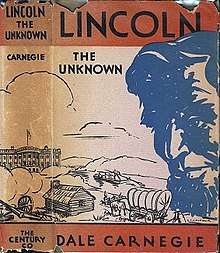Lincoln the Unknown
Lincoln the Unknown is a biography of Abraham Lincoln, written in 1932 by Dale Carnegie. It is published by Dale Carnegie and Associates, and given out as a prize in the Dale Carnegie Course.
 First edition | |
| Author | Dale Carnegie |
|---|---|
| Cover artist | K. S. Woerner |
| Country | United States |
| Language | English |
Release number | 1932 |
| Subject | Abraham Lincoln |
| Publisher | The Century Company |
| Pages | 256 |
| Preceded by | Public Speaking and Influencing Men in Business |
| Followed by | Little Known Facts About Well Known People |
Summary
Abraham Lincoln, a farm boy, becomes the President of the United States. He travels miles to borrow books; reading being the dominant passion of his for quarter of a century. He mourns the loss of his first love his whole life. He humors his colleagues in the White House, and lives with the difficulties of the marriage with his second love, while in war with the South.
Inspirations and writing process
One spring day, Dale Carnegie was breakfasting at a hotel in London. He came across a column in the Morning Post newspaper entitled "Men and Memories". On that particular morning and for several mornings following, that column was devoted to Abraham Lincoln—the personal side of his career. Carnegie read those with profound interest, and surprise. He had always been interested in the United States history. Aroused by the articles in the Morning Post, Carnegie went over to the British Museum Library and read a number of Lincoln books; the more he read, the more fascinated he became. Finally he determined to write a book on Lincoln, himself.
Carnegie began the work in Europe, and labored over it for a year there, and then for two years in New York. Finally he tore up all that he had written and tossed it into a waste-basket. He then went to Illinois, to write of Lincoln on the very ground where Lincoln himself had dreamed and toiled. For months he lived among people whose fathers had helped Lincoln survey land, build fences and drive hogs to market. For months he delved among old books, letters, speeches, half-forgotten newspapers and musty court records, trying to understand Lincoln.
Carnegie spent one summer in the little town of Petersburg. He went there because it is only a mile away from the restored village of New Salem, where Lincoln spent the happiest and most formative years of his life. The same white oaks under which Lincoln studied, wrestled and made love were still standing. Every morning Carnegie used to take his typewriter and motor up there from Petersburg, and wrote half of the chapters of his book under those trees. He often used to go alone to the woods along the banks of the Sangamon, on summer nights, realizing that on such nights Lincoln and Ann Rutledge, his first love, had walked over this same ground.
When Carnegie came to writing the chapter dealing with the death of Rutledge, he drove over the country roads to the quiet, secluded spot where she lay buried. It was abandoned and overgrown, so to get near her grave, he had to mow down weeds, brush and vines. Carnegie also wrote many of the chapters in Springfield. Some in the sitting-room of the old home where Lincoln lived, some at the desk where he composed his first inaugural address, and others above the spot where he came to court and quarrel with Mary Todd Lincoln.[1]
Reception
Dixon Ryan Fox, professor of history in Columbia University, wrote: "A fascinating book, as dramatic as a Sabatini novel. It is just in portraiture and wise in emphasis. It is the most vivid volume I have read on Lincoln's whole life."[2][3]
Lowell Thomas wrote: "The most amazing story in American history. It is a Lincoln book that perhaps could not have been written until today—and a book that no man can read without profit. I know of no other short work on Lincoln which presents so much of him and presents it so unforgettably."[2][3]
Homer Croy wrote: "It's a wonder! I've always been a Lincoln bug and have read many volumes on him. This comes nearer to making Abraham Lincoln a living, breathing human being than any book that I have ever read. This book takes Lincoln out of the sky, moves him into the house next door and makes a neighbour of him. He's as human as a pair of overalls flapping on the clothes-lines."[2][3]
Anthropodermic bibliopegy
A portion of the binding in the copy of Dale Carnegie's "Lincoln the Unknown" that is part of Temple University's Charles L. Blockson Collection was "taken from the skin of a Negro at a Baltimore Hospital and tanned by the Jewell Belting Company".[4] "Lincoln the unknown" is an important example of anthropodermic bibliopegy.
References
- Lincoln the Unknown by Dale Carnegie 1932, p. How this book was written—and why.
- "Lincoln the Unknown (Cedar Books): Front". Retrieved 2012-11-12.
- "Lincoln the Unknown (Cedar Books): Back". Retrieved 2012-11-12.
- Temple University Libraries and Charles L. Blockson, Catalogue of the Charles L. Blockson Afro-American Collection: A Unit of the Temple University Libraries, Temple University Press, 1990, p. 16. ISBN 0877227497
Bibliography
- Carnegie, Dale (1932). Lincoln the Unknown. Cedar Books.CS1 maint: ref=harv (link)